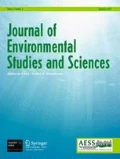Abstract
From water to energy, and from climate change to natural hazards, the geosciences (marine, Earth, and atmospheric science) have an important role to play in addressing a wide range of societal issues, with particular relevance to how humans can live sustainably on Earth. Although arguably important to developing solutions for many societal issues, more often than not, students have limited exposure to the geosciences in high school or college. To address this geoscience literacy problem, the Interdisciplinary Teaching of Geoscience for a Sustainable Future (InTeGrate) Talent Expansion Center has engaged members of the geoscience community and their colleagues in allied disciplines to implement and support strategies to teach geoscience in the context of societal issues and vice versa. Place-based learning is a particularly useful educational practice in helping link geoscience concepts to societal issues and other disciplines. The three examples from three distinctly different institutions of higher education—University of Utah, Metropolitan State University, and West Chester University—demonstrate the use of place-based educational strategies to connect the geosciences to societal challenges. Each of these courses uses variations of place-based pedagogy to provide students from a variety of disciplines the opportunity to learn about geoscience concepts in the context of environmental challenges in their own area. Each example describes the course in the context of its institutional setting, student audience, type of course, and learning outcomes; the geoscience-related societal challenges addressed, a description of pedagogical strategies, basic assessment information, and reflections on lessons learned and recommendations. These three examples illustrate that local places—on-campus, the surrounding community, and regional landscapes—provide a plethora of opportunities for students to apply their classroom knowledge to real-world issues. The extent to which an instructor will take advantage of the place-based opportunities is only limited by the imagination of the instructor(s) and the extent to which they want to use these pedagogies to achieve their learning objectives. Teaching geoscience in the context of societal issues using place-based educational practices illuminate the process of geoscience and build interdisciplinary problem-solving skills that connect geoscience to economic, societal, and policy issues related to a range of issues. Students think critically, ask critical questions, reflect and act on viable alternatives, and acquire knowledge, skills, and training so they can make a real difference in the world.
Similar content being viewed by others
References
Bateson G (2002) Mind and nature: a necessary unity. Hampton Press, Cresskill
Bralower TJ, Feiss PG, Manduca CA (2008) Preparing a new generation of citizens and scientists to face earth’s future. Lib Educ (Spring Issue):20 – 23
Bransford JD, Brown AL, Cocking RR (eds) (2000) How people learn: brain, mind, experience, and school. National Academy of Sciences, Washington, DC, 374 p
Burian SJ and Barbanell EM (2010) “Hydrotopia: integrating civil engineering and humanities to teach water resources engineering and management.” American Society for Engineering Education (ASEE) Annual Conference Proceedings, 20-23 June, 2010, Louisville, KY
Burian SJ, Barbanell EM, Blevins M (2011) “Avoiding another Tower of Babel: Bridging communication barriers among students and instructors from civil engineering, humanities, and other disciplines in a multidisciplinary course.” American Society for Engineering Education (ASEE) Annual Conference Proceedings, 26-29 June, 2011, Vancouver, BC, Canada
Davis B, Sumara D (2006) Complexity and education: inquiries into learning, teaching, and research. Routledge, New York
Doll WC, Fleener MJ, Trueit D, St. Julien J (eds) (2008) Chaos, complexity, curriculum, and culture: a conversation. Peter Lang, New York
Gosselin DC, Manduca C, Bralower T, Mogk D (2013) Transforming the teaching of geoscience and sustainability”. Eos 94(25):221–222
Gruenewald DA, Smith GA (eds) (2008) Place-based education in the global age: local diversity. Lawrence Erlbaum, New York
Hooke RL, Martin-Duque JF, Pedraza J (2012) Land Transformation by humans: a review. GSA Today 22:4–10
Knowles MS, Holton EF III, Swanson RA (2011) The adult learner; the definitive classic in adult education and human resource development, 7th edn. Elsevier, New York
Marsh GP (1865) Man and nature; or, physical geography as modified by human action. Charles Scribner, NY
Mason M (2008) Complexity theory and the philosophy of education. Wiley-Blackwell, Oxford
Semken S (2012) Place-based teaching and learning. Encyclopedia of Learning. Springer Science+Business Media. doi:10.1007/978-1--4419-1428-6_1739
Smith GA, Sobel D (2010) Place- and community-based education in schools. Routledge, New York
Turcotte DL (1997) Fractals and chaos in geology and geophysics, 2nd edn. Cambridge University Press, New York
Zoback ML (2001) Grand challenges in earth and environmental sciences: science, stewardship, and service for the twenty-first century. GSA Today 41–47
Acknowledgments
This work is supported by a National Science Foundation (NSF) collaboration between the Directorates for Education and Human Resources (EHR) and Geociences (GEO) under grant DUE - 1125331. Any opinions, findings, conclusions, or recommendations expressed in this paper are those of the authors and do not necessarily reflect the views of NSF. The authors would like to thank Cathy Manduca, Jean MacGregor, and Rick Oches for hosting the workshop that brought the authors together.
Author information
Authors and Affiliations
Corresponding author
Rights and permissions
About this article
Cite this article
Gosselin, D., Burian, S., Lutz, T. et al. Integrating geoscience into undergraduate education about environment, society, and sustainability using place-based learning: three examples. J Environ Stud Sci 6, 531–540 (2016). https://doi.org/10.1007/s13412-015-0238-8
Published:
Issue Date:
DOI: https://doi.org/10.1007/s13412-015-0238-8




